| |
|
Previous: Fairings |
|
| |
|
02/26/2006 - Return to Flight - 2.5 hours
Finally, after almost two weeks of bad weather, I can get back into the air. Not that I wasted the time, since I was able to get the fairing work completed, but it was still a bit frustrating.
The first thing I did was to verify the status of the EGT sensor that I replaced. I'm happy to report that the new one is working flawlessly and I no longer have a seismograph for EGT #2.
Here's a picture I snapped of TKI as I departed. |
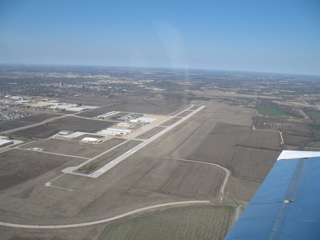 |
| |
|
The next thing I did was to take the plane up to 5500 feet and do some speed runs. The proceedure I used was to establish level flight at a given RPM and then record the ground speed. I recorded the speed in four directions (N,W,S,E) and then averaged the totals. The EFIS makes this pretty easy.
The bottom line is that the plane is performing as I expected it would. I have more testing to do, but here are some preliminary numbers. |
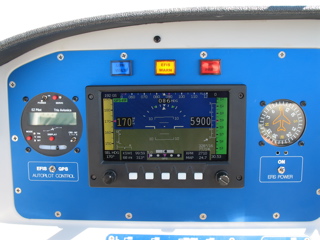 |
| |
|
| RPM |
IAS |
TAS |
| 2300 |
143 |
158 |
| 2400 |
156 |
168 |
| 2600 |
165 |
185 |
| 2700 |
170 |
189 |
These numbers were taken with an OAT of 44°.
Also note that at 2300 RPM cruising along at 158 mph, the fuel flow was 6 gph. That's 26 miles per gallon! |
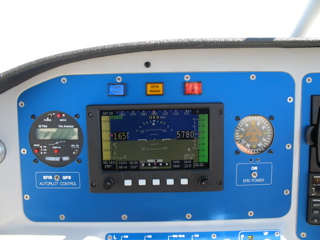 |
| |
|
After about two hours of this, I stopped back at Sherman for some more cheap gas. The landing was definitely different. The plane kept on floating for what seemed like forever. Those fairings really do make a big difference.
I looked over the fairings to see if there was anything out of the ordinary after the first landing. Everything looked good. |
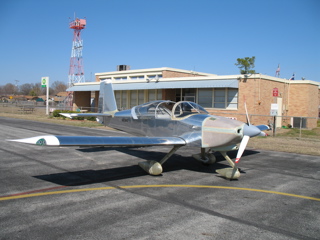 |
| |
|
The landing back at TKI was also a floater, but with 7000+ feet of runway it wasn't a problem.
The only issue I have with the fairings is that now the slip/skid ball is about 1/2 out of center. I'm going to try to adjust the fairings slightly to remedy this. |
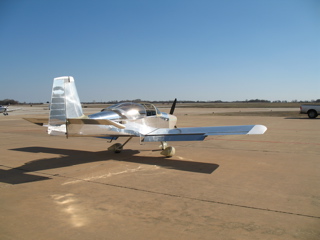 |
| |
|
2/28/06 - Flight to Texoma - 1.6 hours
Today I went to visit another -9A builder named Paul, who has his project in a hangar at AeroCountry (T31). I've flown into there once before, but this is the first time with my own plane. The paved part of the runway is about 3000 feet long, so I had to be more careful about my landing, but it wasn't a problem.
After the visit I flew up to Texoma State Park, (F31). |
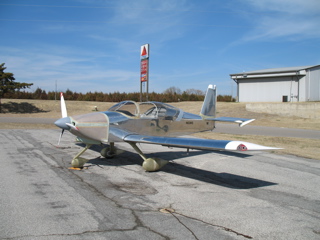 |
| |
|
Texoma's runway is 3000 feet long as well, but the approach puts you over the lake and when you land to the south you're looking into a canyon of trees. I flew here a couple of years ago in the Cessna 150 I had trained in, and I had a heck of a time with the landing. This time, however, it was no big deal at all. I didn't use even half of the runway. Good thing too, since you have to back taxi to get to the parking area.
|
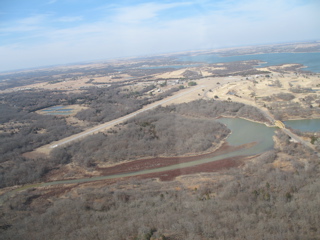 |
| |
|
There's a little convenience store right next to the parking area. I ran inside to grab a drink as it was a fairly warm day.
When I departed, I practiced a short field takeoff using 10 degrees of flaps. I had talked with Paul about this while at AeroCountry and did it when I left there as well. He said I was off in 250 feet. |
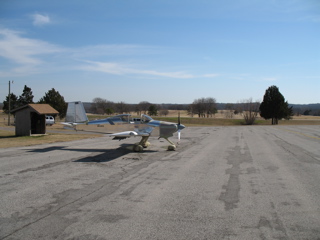 |
| |
|
Although it was a warm day you can tell from the brown foliage in the pictures that it's still winter here in Texas. Wait, oops, technically this is Oklahoma, isn't it. Hey, this is the first time N63MS has been out of state.
I'm getting close to having 10 tach hours on the engine, so I purchased some more mineral oil as well as some DC-4 compound and an oil analysis kit. I already have a replacement filter. I'll probably do an oil change after my next flight. |
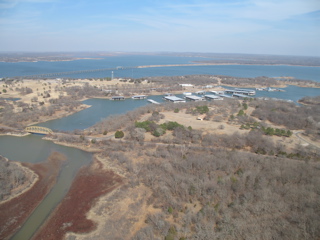 |
| |
|
3/2/06 - Flight/First Oil Change - 1.7 hours
Today was slated as oil change day, and since I needed the oil to be warm I started by making a cross-country to Mt. Pleasant for gas. Mt. Pleasant is about as far away from TKI that I can fly to in a straight line. Today I had a headwind and I throttled back some and made the trip out last an hour.
Here is a picture of Sulphur Springs (SLR) as I flew by at 2500 feet. |
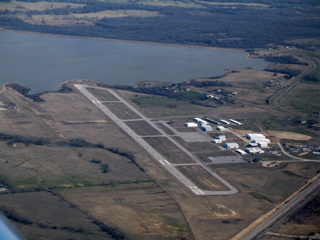 |
| |
|
Upon returning it was time to get down to business. I had read a cool writeup on AvWeb about proper techniques to use when doing an oil change. So, I tried my best. The first problem was that I couldn't get a good grip on the filter. So I had to make a trip to Wal-Mart to buy an oil filter wrench. When I returned I found that it just barely fit, so I had to make a few modifications to the wrench. During this whole time the oil was draining nicely from the quick drain I had installed previously. I finally got the filter loose and I did the whole poke the hole in the back side of the filter thing. It took me way longer than it should have, but in the end I got it done. |
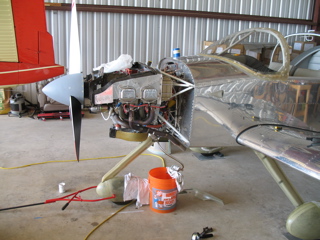 |
| |
|
I also checked the torque on the propeller bolts and re-safetied them. Craig says to do this after 10 hours. I'm going to do this at each annual as well.
It was too late in the day to go fly again to check for leaks, but I'll do that next time. |
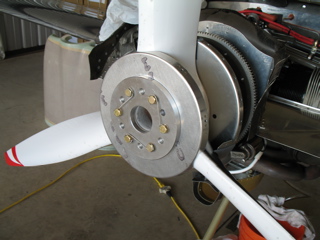 |
| |
|
3/4/06 - Flight Testing - 4.8 hours
Today I spent the majority of the day flying. I used my flight test cards to test slow flight characteristics, the effects of climbs and descents on the engine. I also did speed tests at 3000 feet. In the process I flew out to Gladewater, TX and also to Sherman, TX. |
| |
|
3/5/06 - More Flight Tests - 3.4 hours
Today was pretty cloudy but I managed to stay below the cloud deck and get some testing done. It was challenging to do the power-on stall tests because the clouds were at about 3500 feet and it took about 1000 feet to stall the plane at full power, so I did a lot of descending after each test. |
 |
| |
|
Here's the data:
Power off (no flaps) : 57 mph
Power off
(partial flaps) : 52 mph
Power off (full flaps) : 49
2200 RPM (no flaps) :
53
Full Power (no flaps) : 51
Note that the full power stall was difficult to obtain given the clouds, so I may do that one again later.
Here's a weird-shaped lake. Looks sort of like a dinosaur. |
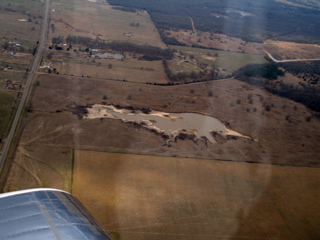 |
| |
|
When I went for fuel I was parked behind this Robinson R44 helicopter.
When I finished fueling, I started the engine and booted the efis. Unfortunately it showed an error with serial communications between the AHRS, EIS, GPS, and SL40...pretty much everything. I was stumped but I had the backup airspeed and altimeter on the EIS, so I headed for McKinney. Enroute I tried reloading the settings from the backup file. This worked and after about two minutes I had the EFIS back. So after I landed at TKI and made sure everything was cool, I flew for another hour. By this time the clouds had moved on. |
 |
| |
|
Today was a really good day to have the weather part of the 396. I was able to keep an eye on the weather and fly to where it was clear.
I now have 23 hours on the plane. Tomorrow the plane goes to the paint shop. It will be there for approximately four weeks. This is unfortunate but necessary if I want the plane to be really "finished." So in the morning I will fly the plane to GLO Custom, which is about a 20 minute flight. These are the last pictures I will take of my unpainted airplane. |
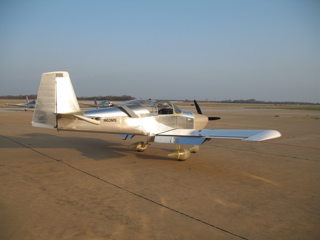 |
| |
|
 |
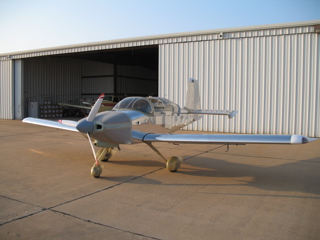 |
| |
|
Next: Paint Shop |
|
| |
|

